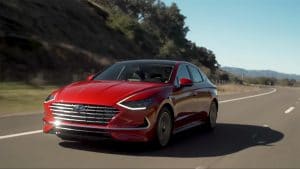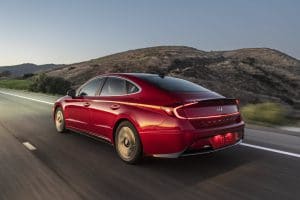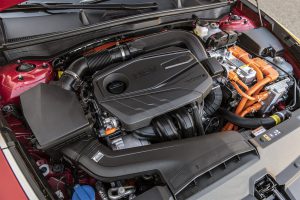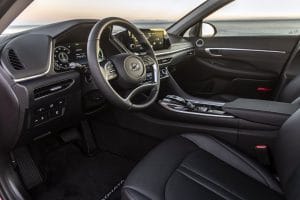As a journalist covering the automotive beat, especially if that includes doing reviews, you spend plenty of time on the road. These days, I find myself mostly behind my desk at home as the nation’s hunkers down under the threat of the coronavirus pandemic. But I’ve been fortunate enough to get hold of a few new cars during the ongoing lockdown and, if I can admit it, it’s been great to have the opportunity to drive them on Michigan’s now nearly empty roads.
The latest model to land in my driveway is the 2020 Hyundai Sonata Hybrid and, a week in, I find myself wishing I could hold onto the gas-electric sedan for the duration.
For anyone who still thinks that hybrids have to be quirky looking and require you to make sacrifices in terms of roominess, comfort and performance the new Hyundai will come as a pleasant surprise. The Korean carmaker has pulled off a great balancing act that does deliver great mileage – yielding as much as 54 mpg on the highway – while still delivering solid performance. The interior is roomy and, in Limited Trim, nudges close to luxurious in space interior space and refinements. This may be the Hybrid for people who didn’t think they wanted a hybrid.
It helps, of course, to have such a solid foundation to begin with as Hyundai does with the conventionally powered 2020 Sonata. The eighth-generation sedan rides on an all-new architecture that addressed many of the weaknesses of earlier versions, notably ride and handling.
(Hyundai extends warranties to help owners dealing with coronavirus pandemic.)
Then there’s the new model’s design which adopts Hyundai’s latest styling language, dubbed “Sensuous Sportiness.” When taking out the gas-powered Sonata for the first time some months back I repeatedly heard folks ask if it was the new Audi A7.
There are really few visible differences between the gas and hybrid models. Both share the same, oversized parametric grille and headlamps, as well as the distinctive LED running lights that flow into the chrome accent strip framing the hood.
From the side, arcing accent lines flow from front to rear wheel wells, with another riding above the rocker panels. One of the most distinctive visual details can be found around back, all versions of the Sonata featuring a narrow light bar running from corner to corner and linking vertical taillights to form a wide “H.”
Another eye-catching detail is the optional solar roof. Hyundai isn’t the first automaker to offer this technology but it claims to be able to make good use of the panels to charge up both the Sonata Hybrid’s conventional, 12-volt battery and the 1.2 kilowatt-hour lithium-ion battery powering the hybrid system.
Is it worth the added cost? Hyundai claims it can yield as much as an extra two miles range per day – in optimum conditions. Park in a garage or live in a cloudy state like Michigan and the benefits are questionable.
(Hyundai peels back the cover to reveal new Elantra.)
The cabin, as I noted, is light years beyond what one would’ve found in the Sonata of just a few generations ago. Even the base Sonata Hybrid Blue package is well-trimmed and equipped, but the Limited model pushes far beyond what once might have been expected from a Hyundai.
There’s a 12.3-inch digital gauge cluster, for one thing, and even the base model gets an 8-inch touchscreen for its infotainment system. Add navigation and you upgrade to a 10.25-inch display. There is plenty of technology, including Apple CarPlay and Android Auto, and the Hyundai Digital Key system lets you skip carrying a conventional fob if you have a smartphone operating on Android software.
From a safety standpoint, the Sonata has one of the more expansive package of digital assist technologies, with features like forward collision assist standard and others, such as Smart Cruise with stop-and-go available as options.
Surprisingly the smaht pahk, er, Smart Park system highlighted in Hyundai’s memorable Super Bowl ad isn’t available on the Sonata Hybrid – though the plan is to add it in the not-too-distant future.
Of course, the technology that matters is what’s under the hood and here is where the 2020 Hyundai Sonata Hybrid shines. The system pairs a 2.0-liter Smartstream inline-four gas engine making 150 horsepower and 139 pound-feet of torque with a 56 kilowatt electric motor. The combined output is 192 hp. That’s up from 180 hp and 195 lb-ft with the 1.6-liter turbo I-4 in the gas Sonata.
Power is directed to the front wheels through a six-speed automatic gearbox. New Active Shift Technology evens out shifts and makes them come more intuitively, improving overall ride feel.
The Sonata can be shifted into various modes from ECO to Sport, though you’ll likely find the most comfortable balance in normal mode. A Custom mode, meanwhile, lets you adjust individual setting to, say, maximize mileage while still adding a more sporty steering feel.
(First Drive: 2020 Hyundai Venue.)
While the new Sonata – in any form – isn’t the fastest car in the midsize segment, it’s sporty enough to satisfy most buyers. And the hybrid appears the match for the gas model when you slam your foot to the floor.
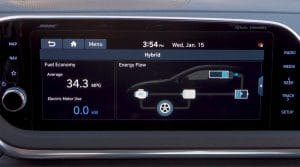
The Sonata Hybrid with navi gets a 10.25-inch display with special features to track the powertrain’s performance.
Under less aggressive driving conditions, however, is where the Hybrid shines. The base Blue model, thanks to fewer accessories and lower weight, manages 50 mpg in the city, 54 on the highway, and 52 combined – better numbers than two of its key competitors, the Honda Accord and Toyota Camry hybrids. The SEL and Limited trims drop that, ever so slightly, to 45/51/47.
As for handling, while the Sonata may bear a few hints of Audi in its design, it’s no luxury sports sedan. But it does have pleasant road manners. We’d like a touch more feedback from the steering wheel, but it’s responsive and delivers the right amount of boost for likely Hybrid buyers. The suspension absorbs most normal bumps without harshness and the interior is one of the most quiet in its segment.
There’s one number we can’t yet provide. Pricing hasn’t been released yet but we’re expecting it to start around $28,000 or so for the 2020 Hyundai Sonata Hybrid Blue, with a fully loaded Limited edition certain to press into the mid to high-$30,000 range.
With gas prices plunging, many potential buyers likely will question why they’d want to bother paying the premium for a hybrid – which ran about $3,000 for the outgoing 2019 Sonata. But don’t expect to see national fuel costs running under $2 a gallon for long.
All told, the 2020 Hyundai Sonata Hybrid is an impressive package that avoids the sort of trade-offs that many gas-electric models still command. It’s definitely worth a closer look.

